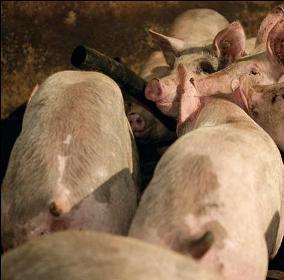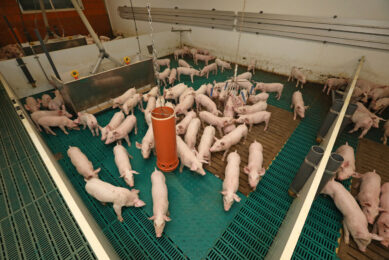Environment and welfare melt Dutch cost advantage

The Netherlands used to be a country where cost efficiency was a key element in production. Surface area requirements and increasing prices for manure disposal are likely, however, to change that picture. A Dutch comparative study into cost prices around the world reveals a gloomy picture.
By Robert Hoste, pig production economist, Wageningen UR, the Netherlands
Undoubtedly, the most important cost pushing factor in the last few years has been feed prices. Another determining economic factor is the fluctuation in currency exchange rates. However, production costs are also influenced by governmental regulations taking into account societal responsibility issues such as environmental protection or animal welfare. Such cost increases are less unexpected within countries, however, as societal topics can take many years until they result in political measures, or that companies, or retailers, implement such elements into their purchase conditions. Implementation time and the degree of measures, however, can differ greatly between countries. Also, additional costs do not always mean additional revenues.
In the Netherlands, surface area requirements for fatteners will rise substantially in the next couple of years.
This article firstly looks at a cost comparison of pig production based on the year 2007. Then, cost increases due to societal demands in some European countries are assessed for the years 2007 and 2013. The study, commissioned by the Dutch Ministry of Agriculture, Nature and Food Quality and the Product Boards for Livestock, Meat and Eggs (PVE) was carried out by LEI Wageningen UR, the Dutch Agricultural Economics Research Institute, using the same method as in former studies.
Cost of production
In 2007, the cheapest producer from the European countries studied was Denmark, with €1.40/kg of (hot) slaughter weight (excl. VAT). The Netherlands followed with €1.40/kg; however, for farms which regularly expand, a further €0.05/kg slaughter weight can be added for the costs of purchased production rights (see box).
The cost comparison further shows that, within Europe, France is in a good third position while Germany, Poland and Spain are clearly down the list from the first two countries with around €0.20 higher production costs. Production costs in the US and Brazil are considerably lower.
Since 2007, there has been a clear increase in production costs due to a global rise in feed prices. The price of the average feed ration for a closed pig farm rose by 56% between July 2006 and June 2008. Using the feed price level of summer 2008 (June-August), the production cost is €0.18 higher than with the average 2007 feed prices.
Costs for compulsory measures
Production cost differences between countries are partly related to differences in governmental regulations. Within the EU, there is an unequal base situation with respect to existing government measures. The costs for pig farming of selected governmental measures were compared between countries, along with predicted future rises in these costs until the year 2013.
Costs were studied in terms of the environment (manure disposal, ammonia emission reduction measures, energy tax and production rights), animal welfare (pen area per pig and pregnant sow’s group housing), public health, genetically modified (GM) feed stuffs, meat-and-bone-meal, growth promoters) and spatial planning (land price). For each of the topics, the particular regulations per country and the degree of implementation were studied, plus the corresponding costs. Figure 2 shows the total additional costs, divided into cost groups. The costs in 2007 are included in the calculated cost of production in Figure 1.
It is clearly shown that the Netherlands has the highest cost for implementing governmental requirements, in 2007 (€0.20) and in 2013 (€0.26/kg). Costs in the other countries from the study varied between €0.06/kg and €0.08/kg, increasing to up to €0.12/kg in 2013.
In 2007, the total cost of Dutch government policy in the field of the environment was around €0.11/kg slaughter weight, of which €0.08 was for manure disposal. Due to high animal density, manure has to be transported sometimes over 150 km from the production location to the arable farmer, who even demands revenues for accepting pig manure. In 2013, these environmental costs will be some €0.02 higher as a result of increasing demands in the ammonia emission reduction policy, with air scrubbers becoming a necessity for many farms. In other countries, the costs in 2007 were between nil and €0.05/kg, but these will also increase in France, Germany and Denmark by €0.02 or €0.03 to a level of about €0.05 or €0.06/kg. Besides these environmental costs, the costs for production rights in the Netherlands were nearly €0.05/kg.
Welfare costs
In 2007, the costs of animal welfare measures in the Netherlands was €0.02/kg slaughter weight, mainly on account of the surface area requirement for fattening pigs of 0.8 m2 per animal. These costs will increase to €0.05/kg in 2013, due to an increased area of 1.0 m2 per fattening pig and 0.4 m2 per rearing piglet. In Germany, these costs will rise to €0.01/kg, because of demanded 0.75 m2 per fattening pig. In other countries, the additional costs for welfare measures in 2007 and 2013 are almost nil.
Public health
Currently, the EU has an asynchronous licensing system for new GM ingredients. This leads to a current disadvantage of about €0.01/kg slaughter weight, compared to non EU countries. Due to a European ban on the use of meat-and-bone-meal as feed ingredient, a cost disadvantage of another €0.01 or €0.02 has to be taken into account.
The European ban on the use of antimicrobial growth promoters has some negative effect on performance, mainly on farms with poor management. Therefore, for Germany and Spain, €0.01/kg costs is assumed; for Poland, due to an even worse production level, this means a higher loss of €0.03/kg. In total, the present costs for public health measures (restriction on GM feed stuffs and on meat-and-bone-meal and a growth promoters’ ban) vary between €0.03 and €0.06/kg.
Due to a lack of information, the costs for 2013 were assumed to be the same as for 2007. A further rise in the costs due to the limitations for new GM ingredients was not included here. However, according to calculations by the European Commission, a firm cost increase could be expected. If GM ingredients and meat and bone meal in pig feed were authorised, the costs would decline.
For spatial planning, in 2013 a cost item is expected of €0.01/kg in the Netherlands. Land in Denmark is already expensive, costing €0.04/kg slaughter weight.
It is clear that the Netherlands not only had the highest costs in 2007, but these will rise the most in the coming years. As some of its competitors will also face rising costs caused by policy measures, it must be concluded that the relative cost position of the Netherlands will deteriorate. The level of production costs for the Netherlands will then be higher than in France (if other cost factors are assumed to be equal).
For a good competitive position within the EU, common regulations and similar interpretation and implementation of regulations is important. In particular, the high manure disposal costs, ammonia emission regulations, the production rights and the more stringent requirements on living space for fattening pigs in the Dutch Pig Decree will have a negative impact on the production cost development in the Dutch pig farming sector towards 2013.
Some additional costs relate to the high regional density in the Netherlands, which surely also has advantages in terms of sector structure and logistics.
Negative effect
The current EU policy regarding GM feed stuffs and meat and bone meal and the lack of non trade concerns in the context of the WTO negotiations negatively affect the production cost development and competitiveness of the European pig sector compared with third countries.
In Brazil and the US, there tends to be fewer limiting measures with regard to animal welfare and the environment. At state level and among private parties in the US there is increasing interest in animal welfare. The environment does play a role in the US but few or no cost rises have resulted.
Real cost difference
In 2007, the Dutch production costs were €0.41 higher than in the US. As mentioned above, in 2007 the Dutch pig farming sector faced costs amounting to €0.20 as a result of the described policy measures. The other €0.21 is the result of much higher investments, wages and feed prices in Western Europe on the one hand, and the high efficiency of pig production in western Europe and particularly in the Netherlands and Denmark on the other. Compared with Brazil, the production cost difference after deducting costs for policy measures is €0.34. So, when environmental and welfare measures are left out, the cost difference between the Netherlands and the US is €0.21 and between the Netherlands and Brazil €0.34.
Less favourable
It can be concluded that the production cost position of the Netherlands will in the coming years become less favourable as a result of further rising costs resulting from policy measures. It is clear that such societal requirements are unavoidable, since they emanate from a culture of responsibility and stewardship. It is a challenge to learn to cope with high societal demands on one hand, and to deal with clear economic forces on the other.
However, the pig farming sector in the Netherlands does have other advantages, in such fields as skilled staff, entrepreneurship, production size, knowledge and information exchange, service provision, availability of capital and a professional, export oriented meat industry.
Production rights in the Netherlands Pig farmers in the Netherlands are only allowed to have pigs, if a corresponding volume of production rights is available. A production volume regulatory system was first implemented in 1987. After some modulations, the current system is based on production rights per present animal. At the first implementation of the regulatory system, rights were supplied for free to farmers, based on the number of present pigs in the years before. Rights, however, are transferable between farms, which means that stopping farmers sell rights to expanding colleagues. The rights’ price fluctuates; at the time of the cost analysis, the investment amounted to €200 per fattening place and about €550 per sow place. The costs of production rights exist of depreciation and interest costs. However, even after passing the depreciation term, rights can be used. Since farm expansion is rather common, the farm is assumed to be partly based on purchased production rights, with accompanying costs. Due to the definition of ‘costs of production’ and the given production rights’ system in the Netherlands, the €0.05/kg costs for production rights should be considered separately. |
Source: Pig Progress Volume 25 nr 3











